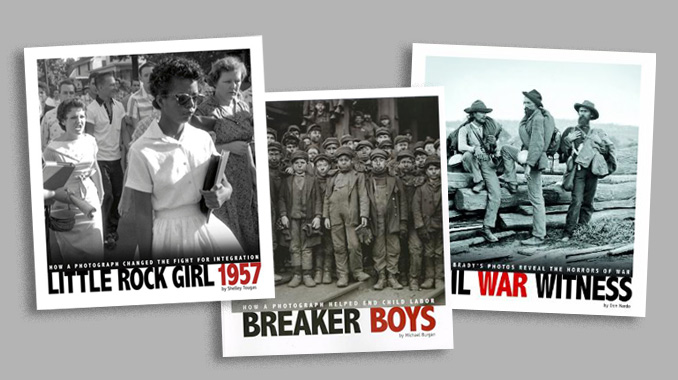Flashback: Historical Photos Transport Us to the Past | Nonfiction Booktalker
Time travel, as envisioned by authors H.G. Wells and/or Jon Scieszka, isn’t happening anytime soon. But all humans can journey into the past using a simple scientific invention that has been around for over a century: The photograph. Staring at a picture of a long-ago event can be a truly transporting experience.

“Captured History” is the perfect name for a fascinating series from Compass Point. Don Nardo’s Civil War Witness: Mathew Brady’s Photos Reveal the Horrors of War (2013) provides a brief history of photography, including the earliest known photo of human beings, taken in Paris in 1838. It’s a shot of a busy boulevard. The exposure time was too long to clearly show all the traffic, but two tiny figures standing in the distance have been immortalized: A man having his boots shined and the man shining them. They never had a clue they were being observed—for all time! Show your booktalk audience the cover photo of three soldiers captured at the Battle of Gettysburg. (Civil War reenactors study this particular photo regularly to be sure their own clothing is accurate.) Who are they? What happened to them? The exposure time was still a problem: Only non-moving things could be photographed. The book has no battle shots. People who imagined that battles were glorious things were appalled to see the photos of dozens of dead bodies—who were the victims? At that time, families were not officially notified of deaths, and some parents actually visited battlefields looking for their sons. Mathew Brady’s studio, with his wagon and cameras, took those Civil War pictures.
Michael Burgan’s Breaker Boys: How a Photograph Helped End Child Labor (2012) shows us that photographs, sometimes horrifying images, do change the world. Lewis Hine went into the tenements of New York City and the coal mines of Pennsylvania to capture images of the appalling conditions in which poor people lived and worked. View the photo of the 17-year-old boy whose leg was amputated after a mining accident. Look at the photos of his dirty young coworkers. Those backless benches they sat on were definitely not ergonomic! If they were lucky, miners lived in filthy, crowded shacks. There were almost no laws to protect workers at the time, and if you were injured, there were no first aid kits, no compensation. Children as young as eight or nine were forced to work to help support their families. When Hine’s work began circulating, reformers finally got involved.
Move on to Shelley Tougas’s Little Rock Girl 1957: How a Photograph Changed the Fight for Integration (2012). Nine young African American students were determined to integrate Central High School in Little Rock, Arkansas. The night before their trip to the school, however, planners realized that the situation was explosive: All of the kids needed to go together. But 14-year-old Elizabeth Eckford’s family had no phone. She didn’t get the message. Alone the next morning, she was surrounded by angry people spewing hate as she walked to school. She must have been absolutely terrified, but she kept her dignity and her stony face, tough and resolute. Photographers surrounded her and caught it all. Americans across the country read the newspapers the next morning and were outraged. Although the students finally made it into the school they faced unceasing cruelty and discrimination. Forty years later, the man who opened the same door to the school for them to celebrate the anniversary was President Bill Clinton. Mercifully, times have changed. Stare at those proud, older faces in a contemporary photo and the same ones from 40 years earlier. Then ask your listeners, “can children change history?”
For further study, look for the other books in this compelling series. Even the history of photography itself can be riveting. After reading the books presented here, I was inspired to Google search the American photographer Robert Cornelius, whose selfie from October of 1839—an image of a good-looking, wild-haired man—is one of the first photos of humans ever produced.
The job outlook in 2030: Librarians will be in demand
The job outlook in 2030: Librarians will be in demand
ALREADY A SUBSCRIBER? LOG IN
We are currently offering this content for free. Sign up now to activate your personal profile, where you can save articles for future viewing






Add Comment :-
Be the first reader to comment.
Comment Policy:
Comment should not be empty !!!